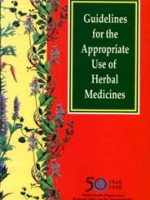Guidelines for the Appropriate Use of Herbal Medicines
- 1998 - 79 pages - 1 Volumes
- Edition : World Health Organization, Regional Office for the Western Pacific Manila
- Langues : Anglais
- Mot-clés : Médecine traditionnelle, Méthodologie, Plantes médicinales
Description :
Reports the findings and recommendations of a working group convened to prepare guidelines for the use of herbal medicines in Western Pacific countries. Addressed to national health authorities, the report responds to the widespread use of herbal medicines in this part of the world and the corresponding need for mechanisms to ensure that these products are safe and effective, yet remain broadly accessible. With this need in mind, the report sets out a comprehensive framework for developing national policies designed to control the safety, efficacy and quality of herbal medicines, manufacturing practices, product registration and labeling, marketing and trade. The report has two parts. The guidelines are presented in the first, which opens with background information about the objectives of national policies aimed at the promotion, development, and regulation of herbal medicines. The need to define the place of traditional care within modern health systems is discussed together with the importance of conserving plant species. Against this background, the guidelines are presented in five chapters. General guidelines for the development of a national policy are followed by advice on the process by which national policies are developed and implemented. Ten specific issues that need to be addressed are identified and discussed. Subsequent chapters outline legal and other options available for the regulation of practitioners, manufacturers and the distribution system. The guidelines conclude with a description of the different regulatory procedures that can be applied to raw plant materials, processed plant materials and medicinal herbal products. The regulation of medicinal herbal products is discussed in terms of detailed requirements for the registration of both traditionally used products and new products. The chapter also includes advice on labeling requirements, the responsible government agency, and establishment of a system for monitoring adverse reactions. The second part includes a summary of the working group’s deliberations and conclusions, followed by brief reports from 14 Western Pacific countries, which document the importance of herbal medicines and summarize existing systems for their regulation and control.



